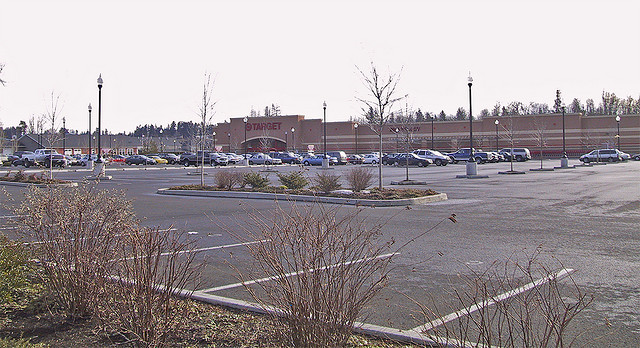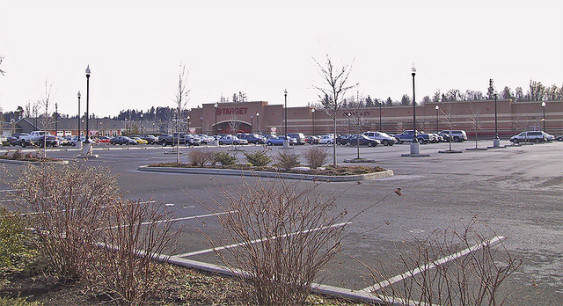Off-street parking quotas are on the books in every city in Cascadia, because they are politically expedient. But the specific quotas—two spaces per apartment or ten per 1,000 square feet of retail floor space, for example—are based on little or nothing. Cities just make them up, then state them with precision, as UCLA professor of urban planning Donald Shoup has documented in The High Cost of Free Parking (see chapter 2).
Here’s how it works. Territorial constituents push city leaders to defend free neighborhood curb parking from newcomers, so the leaders instruct city planners to recommend parking quotas sufficient to prevent spillover from new buildings. No visitor to any new development should ever park on the street, leaders tell planners.
Let’s say you’re a planner in a city department. What are you to do? Like all planners, you were trained in a discipline in which the main curricula and classic text books say nothing at all about parking requirements. You have exactly zero training in how to set a parking requirement.
If you’re typical, what you do is call your peers in nearby jurisdictions and copy their mandates number for number: two off-street spaces per apartment; five per 1,000 square feet of office building; and so on. “It’s magical the way these numbers spread,” parking researcher Richard Willson told LA Magazine. Groupthink fills the void where analysis is lacking. Lewis Carroll, author of Alice in Wonderland, would have readily understood how cities set parking requirements.
If you’re a little more discerning than most planners, and less pressed for time, you might look up the research of the Institute for Transportation Engineers or of the American Planning Association (APA). Both organizations publish references on parking that are impressively elaborate and precise: they are not, however, impressively reasoned. They are, in Shoup’s apt phrase, “closer to numerology than to statistics.” Both warn their readers against misinterpreting them as policy recommendations. They rely on tiny samples of maximum parked-car tallies at unrepresentative, auto-dependent sites. Shoup writes, “transportation engineers survey the peak parking demand [typically the 20th busiest hour of the year] at a few surburban sites with free parking but no transit service.” (See pages 56-57.) For example, they go to suburban malls and count the cars the second Saturday before Christmas, then publish the tally. Such counts are misleadingly called “parking demand studies.” Real demand studies would examine how much parking gets used at different prices, not just when it’s free.
The APA reports parking utilization rates at more than 800 kinds of facilities—from adult bookstores to zoos—complete with charts and graphs and multiple digits to the right of the decimal place, as if the counts were measurements from particle physics. Even if you, the planner, understand statistics and review the methodology and read the warnings, you’ll still be sorely tempted to rely on them as a basis for parking minimums. Your elected bosses want quotas, not excuses, and any plausible intellectual cover will suffice. So, you’ll likely recommend the ITE or APA parking tallies to the city planning commission or council, which will elevate them into law as minimum required parking. In this way, maximum counts of free parking at auto-dependent locations will become minimum parking requirements citywide. In fact, elected officials often round the observed figures up, just to be “safe.” That is, they further increase the radical oversupply of off-street parking.
Parking counts can even become self-fulfilling prophecies. Abundant parking tends to be free parking, because you can’t charge for something that’s not scarce. And free parking powerfully encourages people to drive rather than ride transit, carpool, or other means of travel.
Imagine a law requiring summer camps to stock enough ice cream so that every kid can have unlimited free vanilla or chocolate on demand. It’s a laughable notion. No one could run a camp that way. Almost all cities run their parking that way, though, and the main differences among cities’ parking rules are simply how much ice cream they insist on. John von Neumann, the early 20th Century polymath and foe of misplaced precision, must be spinning in his grave.
Requiring citywide, year-long minimum quotas derived from suburban, free, peak-hour parking is junk science. Imitating others in doing so is groupthink. Yet such flimflam reasoning underlies parking rules across the Northwest and beyond.
I suppose this whole scenario would be amusing, in an eyerolling way, if parking rules did not cause egregious harm to our communities. But they do, and there’s nothing funny about inflating the price of housing (the subject of my next article), subsidizing air pollution, or making city streets less safe for people on foot or bicycles—all consequences of the mandatory oversupply of vehicle storage.
The way cities set quotas is nonsense, and the results are pernicious, but I’m not saying the process is malicious. It’s not. No one acts from ill will. It’s a classic example, in fact, of retail sanity, wholesale craziness. Elected officials respond to voters’ concerns. Transportation engineers do their job of counting cars. City planners do theirs, writing land-use rules. Developers do theirs, following the rules. And the result is stark, raving mad.
A partial remedy would be lower, better-researched off-street quotas, based on sophisticated parking analysis such as King County’s Right-Size Parking study. But the ultimate solution—which I will unfold later in this series—is not better central planning. It is to defuse or counterbalance curb territoriality, put a price on on-street parking, and deregulate off-street parking entirely. City planners should do things they’re trained and expert in, like laying out roads, transit, and parks, not deciding how much parking each apartment building should have. That decision is best left to the people who are building those buildings. After all, their livelihoods depend on understanding their customers’—city residents’—willingness to pay for such things as places to store their cars.
UPDATE, September 11, 2013: Cascadian artist Don Baker has done a cartoon edition of the vicious circle of parking minimums. It’s here.
Thanks to UCLA’s Donald Shoup, whose analysis underlies so much of this article that he might as well be a coauthor.










Natasha Vaughn
Thanks for this great series. The unbundling of street parking (which we’re moving towards here in Ithaca NY with the citywide repeal of off-street parking requirements and the hiring of our first parking manager) has a parallel in Ithaca’s trash collection policy. I have to buy a sticker for $4.50, widely available at grocery stores throughout the area, in order for the trash collection company to take away a full can’s worth. Some people think this is an example of local government nickel-and-diming us, but in reality it’s a strong incentive for me to recycle and compost diligently, and I’m happy knowing I’m not subsidizing someone else’s waste.